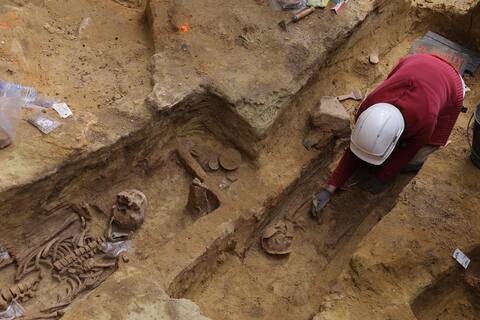These dead were buried in the heart of Paris, and had not been seen since ancient times: a cemetery dating back to the Gallo-Roman period, with many burials and offerings, was discovered during the works, a discovery that will help a better understanding of the life of the “Parisi”.
About fifty skeletons have been buried there since the second century, on the left bank of the French capital, a few meters from the entrance to the Port-Royal station of the RER B line, a railway transport line.
The crater had escaped several road works, including the construction of the RER B in the 1970s. Even creating a new exit for users and prescribing preventive archaeological excavations.
“There was a strong suspicion that we are so close to the southern necropolis of Lutes,” explained Camille Colonna, head of archaeological research and anthropologist at the National Institute for Preservative Archaeological Research (INRAP), the name of Paris in the Gallo-Roman era. ), during a press visit to the site.
Known as the cemetery of Saint Jacques, this is the largest Gallo-Roman city, because it was partially excavated in the 19th century. But very quickly, the methods at the time were only interested in valuables, and gave up skeletons and all other data that made it possible to understand the context.
Everything has since been covered up, and this information has been lost. Fortunately, the previously unexcavated cemetery island has been preserved. “Nobody has seen it since ancient times,” said Dominic Garcia, INRAP President.
“We were very happy: during the survey we found the first skeleton with a coin in its mouth, which allowed us to date the burial to the second century AD,” says Camille Colonna.
Excavations begin in March. About fifty graves were discovered, all for burial – not for cremation as was also practiced.
“A wayfarer from hell”
The deceased were placed in wooden coffins, which themselves are poorly preserved but which archaeologists have managed to restore thanks to the nails that are still there. There men, women and children lie on their backs. It is likely that the Parisians, the people of Gaul settled in the Lutes, under Roman control, according to Dominic Garcia.
A little more than half of the burials are accompanied by deposits: ceramic vessels (jugs, goblets, vases …) or glass. On rare occasions, a coin was placed in the coffin, or in the mouth of the deceased, “a common practice in antiquity which likely marked the grave of the underworld ferryman, Charon,” specifies INRAP.
“Frequently, we find shoes lived on by the presence of small nails that make up the sole. They are either at the feet of the deceased, or beside him, like an offering,” Camille Colonna describes.
Items related to clothing (jewelry, hairpins, belts) were also found. and one pit containing the skeleton of a whole pig, that of another small animal, with two earthenware containers: most likely the “sacrificial pit”.
By the drilling site’s next shutdown, all of these clues will be taken—without exception this time—and sent to the lab.
“This will allow us to understand the life of the Parisian through their funeral rites, as well as the health status of people through the study of their DNA,” said the anthropologist.
These excavations open “a real window into the mortuary world of Paris in antiquity”, while the ancient history of the capital is “generally unknown”, affirms Dominique García. “What we find in the tombs, we also find in the habitat, and this will teach us more about the places of supply of the Parisians of that time,” he rejoices.

“Total coffee aficionado. Travel buff. Music ninja. Bacon nerd. Beeraholic.”








More Stories
What exactly is a “job”?
The Supreme Court should deny Trump any criminal immunity
“Fake Electoral Voters” Republicans | Trump is not indicted in the Michigan proceedings